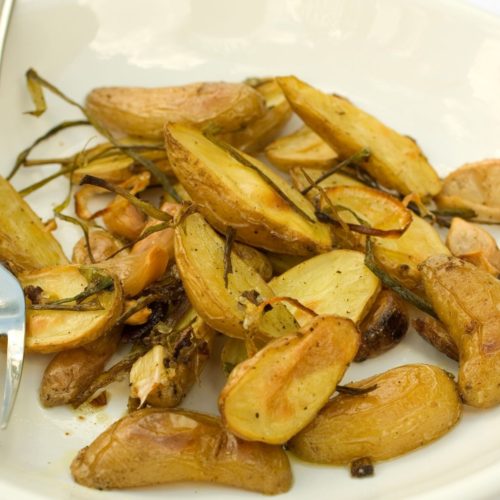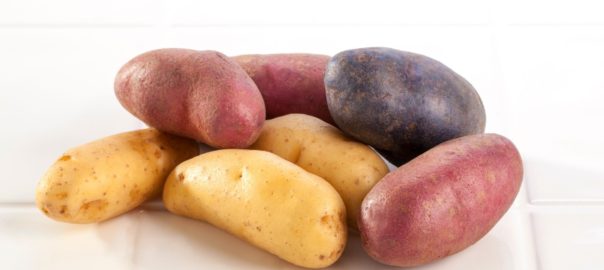There are very few of us who haven’t eaten potatoes in one form or another. Whether you enjoy them baked, roasted, mashed, or steamed, they do offer many health-promoting attributes.
Potatoes have been around for thousands of years, originating in Southern Peru and have since spread around the world. Ultimately making it to the United States in the early 18th century. Potatoes are an incredibly filling food packed with nutrients, relatively inexpensive, and easy to grow and prepare.
For purposes of this post we are talking about white fleshed potatoes, not sweet potatoes.
Health Benefits of Potatoes
Nutritional Content - will vary depending on the variety and how the potatoes are prepared. Let’s be honest, those deep-fried potatoes are not the healthy ones! Potatoes, however, are not always the bad guy that they’re made out to be. They are a good source of potassium, vitamins B6 and C, niacin, pantothenic acid, and dietary fiber.
Antioxidants such as carotenoids, phenolic acid, and anthocyanin help to neutralize potentially harmful free radicals. When these free radicals accumulate in the body our risk of chronic diseases like heart disease, diabetes, and cancer can increase. According to a study published by Preventive Nutrition and Food Science antioxidant content is higher in colored potatoes such as Peruvian Blues versus the common white potato.
Blood sugar control can be improved because potatoes contain resistant starch. Resistant starch is not broken down in the small intestine and can therefore travel to the large intestine. Here it ferments and becomes food for the beneficial bacteria that make up part of your microbiome. When these beneficial bacteria are fed well, they are able to multiply and crowd out the bad bacteria.
To keep the resistant starch high and the glycemic index low, a study published in the National Library of Medicine found that cooking potatoes, placing them in the fridge to cool, then reheating or eating them cold increased the amount of resistant starch levels. Moreover, adding vinegar to the cold potatoes helped reduce the glycemic index. This could be helpful for those managing diabetes.
Digestive health is improved through the resistant starch mentioned above. Feeding the beneficial guys in your gut helps support a healthy digestive system. The fermentation process encourages the production of butyrate which helps to line the gut and keep its integrity healthy. Ultimately, this keeps your colon healthy. Butyrate can help battle constipation as it helps to keep stool moving through your colon.
As you can see, potatoes offer many health benefits, but with over 200 different varieties available – how do we know which one to eat?
Solanines
One important health note when it comes to eating potatoes. If you are someone who is affected by nightshade vegetables you may be sensitive to solanine, a plant alkaloid that can cause joint pain, bloating, gas, diarrhea, fatigue, or nausea, you should not consume potatoes. Other foods which contain this plant compound include
- tomatoes (including tomatillos)
- eggplant
- peppers (all peppers including sweet peppers, paprika spice)
- goji berries
- huckleberries
- ground cherries
- cape gooseberries
- Tobacco — if you use tobacco please quit. The Great American Smokeout Day is the third Thursday in November, but don’t wait
Keep in mind that black pepper is not part of this botanical family and can be safely consumed.
Types of Potatoes
There are three general categories of potatoes which include starchy, waxy, and all-purpose. Each category will have different uses and methods of preparation that will work best.
Starchy potatoes are high in starch and low in moisture. Examples include Russet, Idaho, and Gold Rush potatoes. These work well for baking, roasting, and mashing (be careful not to over work when mashing as they will become gluey).
Waxy potatoes are low in starch and high in moisture. This category includes Fingerling, Yellow, Red Bliss, and New Potatoes (potatoes that have been harvested before fully ripe). Because of the higher moisture content, they work well when boiled, roasted, and in dishes where the potato needs to keep its shape such as potato salad, soups, stews, casseroles, and gratins.
All-Purpose potatoes have both a medium amount of starch and moisture. Varieties include Yukon Gold, Peruvian Blue, and Purple Majesty potatoes. The all-purpose potatoes can be steamed, baked, roasted, and can often be substituted for any starchy or waxy potato.
Purchasing and Storing Your Potatoes
- Select high quality potatoes that are firm, organic being best as much of the beneficial nutrition is in the skin. It is important to avoid wilted, sprouted, discolored, or leathery potatoes.
- Potatoes should be stored in a cool, dark place between 45 to 50 degrees. They do not do well in the refrigerator as the starch content will turn to sugar which produces an undesirable taste. If stored at warmer temperatures potatoes may begin to sprout. A root cellar is best if you are fortunate enough to have one. If potatoes are stored at room temperature, they can last up to two weeks.
- Onions and potatoes should not be stored together or near each other. They both emit gases that will cause the other to breakdown.
- It is best to store potatoes in a burlap or paper bag to protect them from light. When potatoes are exposed to light, they produce chlorophyll which begins to turn green under the skin. Chlorophyll is not poisonous, but unfortunately this indicates a concentration of solanines in the potato which are toxic. The more light the potatoes are exposed to the greater the quantity of solanine. If there is a slight greening, it can be peeled off but if it is green and sprouting, it is best to throw out. A good motto to follow is “when in doubt, throw it out.” Even with this one safety precaution, potatoes are a great addition to your diet.
Best of all, potatoes are easy to add to any meal or be the meal itself. Whether baked, roasted, boiled, steamed, mashed, or added to other dishes, they can provide health-promoting nutrition, antioxidants to battle free radicals, resistant starch for managing blood sugar levels, and improving digestive health.
Here is an easy and tasty recipe to enjoy.

Roasted Rosemary Fingerling Potatoes
Ingredients
- 1 pound tri-color Fingerling potatoes, washed and cut in half
- 4 tablespoons organic extra virgin olive oil, divided plus extra for greasing
- 3 tablespoons fresh rosemary, minced
- 3 cloves garlic, minced
- sea salt and black pepper to taste
- 1 tablespoon extra-virgin olive oil
- 2 large yellow onions, peeled and cut thinly
Instructions
- Preheat oven to 425°F
- Lightly grease a rimmed baking sheet with olive oil or line with parchment paper or a silicone baking mat
- Place potatoes, 2 tablespoons olive oil, rosemary, and garlic in a bowl and toss to combine
- Add sea salt and black pepper
- Layer potatoes on the baking sheet in a single layer
- Roast in preheated oven for 15 minutes
- Gently toss potatoes to help them brown evenly and return to the oven
- Roast for another 10-15 minutes, potatoes should be fork-tender
- While potatoes are roasting, add onions and 2 tablespoons olive oil to a large skillet
- Sautee over medium heat, stirring occasionally, until they turn golden brown, about 10 minutes
- Remove onions from heat
- Place roasted potatoes and sauteed onions in a large bowl and toss to combine
- Add extra sea salt and pepper if neededServe immediatelyEnjoy!
Sources Hart, J. Solanine Poisoning – How Does It Happen? Michigan State University Extension. Published February 7, 2014. Retrieved from https://www.canr.msu.edu/news/solanine_poisoning_how_does_it_happen Hellmann H, Goyer A, Navarre DA. Antioxidants in Potatoes: A Functional View on One of the Major Food Crops Worldwide. Molecules. 2021;26(9):2446. Published 2021 Apr 22. doi:10.3390/molecules26092446. Retrieved from https://www.ncbi.nlm.nih.gov/pmc/articles/PMC8122721/ Lee SH, Oh SH, Hwang IG, et al. Antioxidant Contents and Antioxidant Activities of White and Colored Potatoes (Solanum tuberosum L.). Prev Nutr Food Sci. 2016;21(2):110-116. doi:10.3746/pnf.2016.21.2.110 Retrieved from https://www.ncbi.nlm.nih.gov/pmc/articles/PMC4935237/ Leeman M, Ostman E, Björck I. Vinegar dressing and cold storage of potatoes lowers postprandial glycaemic and insulinaemic responses in healthy subjects. Eur J Clin Nutr. 2005 Nov;59(11):1266-71. doi: 10.1038/sj.ejcn.1602238. PMID: 16034360. Retrieved from https://pubmed.ncbi.nlm.nih.gov/16034360/ Reveille, John D. et al. "The Prevalence Of HLA-B27 In The US: Data From The US National Health And Nutrition Examination Survey, 2009". Arthritis & Rheumatism, vol 64, no. 5, 2012, pp. 1407-1411. Wiley, doi:10.1002/art.33503. Accessed 22 Oct 2021.


